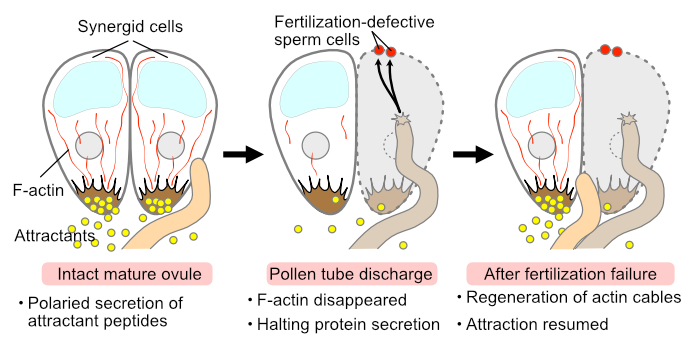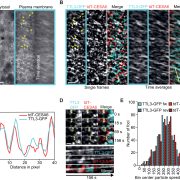F-actin in the synergid cell regulates the secretion of pollen tube attractants like a fishing rod
By Daichi Susaki, and Daisuke Maruyama
Kihara Institute for Biological Research, Yokohama City University, Japan.
Background: The two synergid cells embedded in the ovule of angiosperms play an important role in the male–female interaction during sexual reproduction by secreting pollen tube attractants (e.g., AtLUREs). The micropylar end of a synergid cell has a filiform apparatus, active communication domain with complex plasma membrane invaginations and thick cell walls that presumably secrete the attractant peptides. Immunostaining studies have shown radial microtubules spreading from the filiform apparatus and filamentous actin (F-actin) distributed longitudinally within the synergids. The characteristic morphology and cytoskeletal orientation of synergid cells are thought to be important for their function, but the details are unclear.
Question: What is the function of the cytoskeleton in synergid cells during sexual reproduction?
 Findings: We demonstrated that microtubule destruction compromises the elongation of plasma membrane invaginations in the filiform apparatus. Disruption of F-actin resulted in severe disorganization of synergid cell morphology, causing incomplete filiform apparatus formation and aberrant positioning of the central vacuole. Furthermore, F-actin destruction impaired the secretion of pollen tube attractant peptides and caused female sterility. After pollen tube discharge, the longitudinal F-actin pattern temporarily disappeared in the persistent synergid. Our data suggest that F-actin has a central role in maintaining cell polarity and in mediating male–female communication in the synergid cell.
Findings: We demonstrated that microtubule destruction compromises the elongation of plasma membrane invaginations in the filiform apparatus. Disruption of F-actin resulted in severe disorganization of synergid cell morphology, causing incomplete filiform apparatus formation and aberrant positioning of the central vacuole. Furthermore, F-actin destruction impaired the secretion of pollen tube attractant peptides and caused female sterility. After pollen tube discharge, the longitudinal F-actin pattern temporarily disappeared in the persistent synergid. Our data suggest that F-actin has a central role in maintaining cell polarity and in mediating male–female communication in the synergid cell.
Next step: The genes that regulate the polar secretion and cell morphology of synergid cells remain to be identified in further studies. Such studies will further our understanding of the mechanisms that underlie pollen tube attraction and polytubey block, the process by which the ovule limits the number of pollen tubes it attracts.
Daichi Susaki, Rie Izumi, Takao Oi, Hidenori Takeuchi, Ji Min Shin Naoya Sugi, Tetsu Kinoshita, Tetsuya Higashiyama, Tomokazu Kawashima and Daisuke Maruyama. (2023). F-actin regulates the polarized secretion of pollen tube attractants in Arabidopsis synergid cells https://doi.org/10.1093/plcell/koac371









